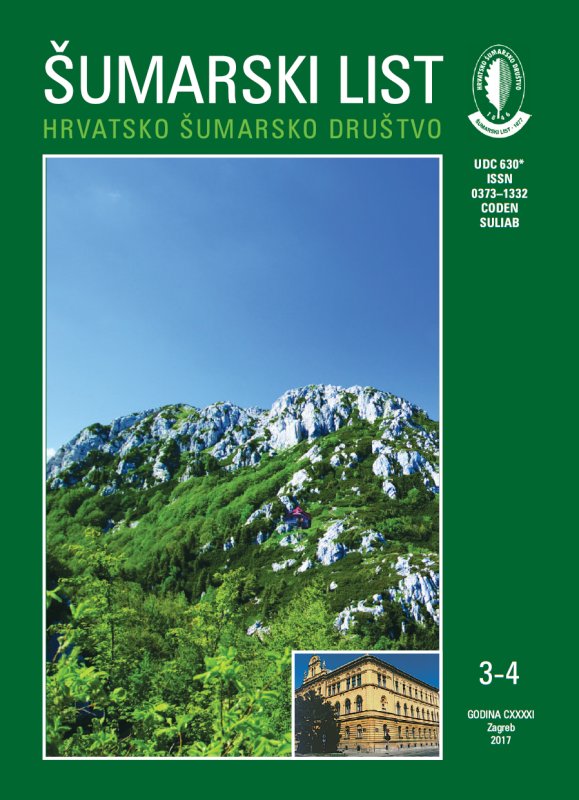
broj: 3-4/2017
pdf (15,8 MB) |
|
||||||||||||||
| RIJEČ UREDNIŠTVA | ||
| Uredništvo | ||
| WHAT, IF ANYTHING, HAS CHANGED? pdf HR EN | 113 | |
| IZVORNI ZNANSTVENI ČLANCI | ||
| Jelena KRANJEC, Marno MILOTIĆ, Marija HEGOL, Danko DIMINIĆ | UDK 630* 449 (001) https://doi.org/10.31298/sl.141.3-4.1 | |
| FUNGUS-LIKE ORGANISMS IN THE SOIL OF DECLINING NARROW-LEAVED ASH STANDS (Fraxinus angustifolia Vahl) pdf HR EN | 115 | |
| Ali DURKAYA, Birsen DURKAYA, Ali SABANCI, Sinan KAPTAN | UDK 630* 537 (001) https://doi.org/10.31298/sl.141.3-4.2 | |
| EVALUATION OF THE EFFECTS OF VARIOUS FACTORS ON ABOVEGROUND AND BELOWGROUND BIOMASS STORAGE CAPACITY OF EASTERN MEDITERRANEAN MAQUIS VEGETATION pdf HR EN | 123 | |
| Kyriaki KITIKIDOU, Elias MILIOS, Panagiota PALAVOUZI | UDK 630* 582 (001) https://doi.org/10.31298/sl.141.3-4.3 | |
| Development of an ensemble classifier with data from description sheets To classify forest stands in site qualities pdf HR EN | 131 | |
| Abstract Aim of study: In this work, we tested the technique of combining the predictions of classifiers for the development of a single, ensemble classifier, in order to classify forest stands in site qualities. Area of study: We used data of the forest stands of Dadia – Lefkimi – Soufli forest (north-eastern Greece). Materials and methods: The variables that we used as input were the altitude, slope, age and canopy density. For the ensemble classifier development we applied the boosting algorithm. Main results: The canopy density was the most important predictor; topography which replaced altitudes and slopes was the second important predictor, while the developed ensemble classifier gave a percentage of correct classification up to 98.59% (for the worst site quality). Research essentials: If we consider that the initial site classification comprised over 70% of the Dadia-Lefkimi –Soufli forest area in the worst site quality, then the usage of boosting method for creating a collective classifier for site qualities in the studied forest can be characterized as fully successful. The application of this method using these input parameters do not need background information regarding the tree age and (or) other difficult to access information. Moreover, in a quite high degree, this site classification is not influenced by disturbances. The boosting method for creating a collective classifier for site qualities obviously will give far more accurate classifications of site productivity, if a more sophisticated scheme of data collection is used. Key words: ensemble classifiers; forest stands; site qualities. | ||
| PRETHODNO PRIOPĆENJE | ||
| Matija STERGAR, Klemen JERINA | UDK 630* 156 https://doi.org/10.31298/sl.141.3-4.4 | |
| WILDLIFE AND FOREST MANAGEMENT MEASURES SIGNIFICANTLY IMPACT RED DEER POPULATION DENSITY pdf HR EN | 139 | |
| Ljiljana KEČA, Milica MARČETA, Stjepan POSAVEC, Sreten JELIĆ, Špela PEZDEVŠEK-MALOVRH | UDK 630* 899 https://doi.org/10.31298/sl.141.3-4.5 | |
| MARKET CHARACTERISTICS AND CLUSTER ANALYSIS OF NON-WOOD FOREST PRODUCTS pdf HR EN | 151 | |
| IZVORNI ZNANSTVENI ČLANCI | ||
| Erhan ÇALIŞKAN, Uzay KARAHALIL | UDK 630* 686 + 383 (001) https://doi.org/10.31298/sl.141.3-4.6 | |
| EVALUATION OF FOREST ROAD NETWORK AND DETERMINING TIMBER EXTRACTION SYSTEM USING GIS: A CASE STUDY IN ANBARDAG PLANNING UNIT pdf HR EN | 163 | |


